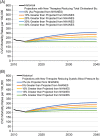Protecting the gains: What changes are needed to prevent a reversal of the downward cardiovascular disease mortality trend?
- PMID: 30318600
- PMCID: PMC6436516
- DOI: 10.1002/clc.23097
Protecting the gains: What changes are needed to prevent a reversal of the downward cardiovascular disease mortality trend?
Abstract
Aims: Cardiovascular disease (CVD) mortality has decreased over 60% over the past 50 years in the United States; however, emerging data indicate CVD incidence may be rising because of shifting demographics, increasing risk factor prevalence, and competing needs for limited resources. We projected CVD mortality from 2015 to 2040 given varying informed assumptions regarding changes in risk factor prevalence, uptake of current therapeutic options, and future innovations.
Methods: A microsimulation model was used to project US CVD mortality trends. National Health and Nutrition Examination Survey data were used to estimate population-level trends in CVD risk factors. Risk factors were used to generate Framingham Risk Scores for cohorts of 1 000 000 individuals from the general population to determine each individuals' CVD risk. Annual cardiovascular incidence, prevalence, and mortality were projected for scenarios differing by uptake of current therapies, anticipated pharmaceutical innovations with variable efficacy, risk factor prevalence, and changes in health disparities.
Results: When incorporating a demographic shift, continued changes in risk factors, current treatment utilization, and no major innovations, we predicted the CVD mortality rate would increase 41% by 2040. If innovations providing incremental benefits equal to those associated with the introduction of statins are identified and widely utilized, CVD mortality could remain constant through 2040. With more efficacious innovations, CVD mortality could be further reduced.
Conclusions: Given demographic and risk prevalence changes, increasing access and adherence to current preventative therapeutics could slow the expected mortality increase, but new therapies may be needed to maintain the downward trend in CVD deaths.
Keywords: cardiovascular disease; disease burden; microsimulation model; mortality; projections.
© 2018 Wiley Periodicals, Inc.
Figures





Comment in
-
Trying to create the future.Hellenic J Cardiol. 2023 Jan-Feb;69:57-58. doi: 10.1016/j.hjc.2022.11.003. Epub 2022 Nov 29. Hellenic J Cardiol. 2023. PMID: 36460162 No abstract available.
References
-
- Benjamin EJ, Blaha MJ, Chiuve SE, et al. American Heart Association Statistics Committee and Stroke Statistics Subcommittee. Heart disease and stroke statistics—2017 update: a report from the American Heart Association. Circulation. 2017;135(10):e146‐e603. 10.1161/CIR.0000000000000485. - DOI - PMC - PubMed
-
- Murphy SL, Xu J, Kochanek KD, Curtin SC, Arias E. Deaths: Final data for 2015. Natl Vital Stat Rep. 2017;66(6):1‐75. - PubMed
Publication types
MeSH terms
Grants and funding
LinkOut - more resources
Full Text Sources
Miscellaneous

